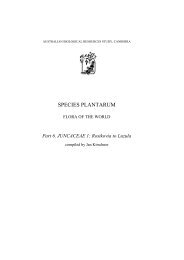Part 7. JUNCACEAE 2: Juncus - Species Plantarum Programme
Part 7. JUNCACEAE 2: Juncus - Species Plantarum Programme
Part 7. JUNCACEAE 2: Juncus - Species Plantarum Programme
You also want an ePaper? Increase the reach of your titles
YUMPU automatically turns print PDFs into web optimized ePapers that Google loves.
4<br />
SPECIES PLANTARUM — FLORA OF THE WORLD (2002)<br />
KEY TO SUBGENERA AND SECTIONS<br />
1 Inflorescence racemose, with the pair of floral bracteoles absent; flowers<br />
usually in heads or clusters, rarely borne ±singly (subg. <strong>Juncus</strong>)<br />
2 Leaves terete, stem-like, pungent, basal, not septate; vascular bundles<br />
scattered over most of T.S.; lower bract apparently forming a<br />
prolongation of stem sect. 1. <strong>Juncus</strong> (p. 5)<br />
2: Leaves flat, compressed, canaliculate or if terete then usually septate, not<br />
stem-like, basal or cauline; vascular bundles usually in subepidermal<br />
position; lower bract usually not appearing as a stem prolongation<br />
3 Leaves unitubulose or pluritubulose, perfectly septate; if pluritubulose<br />
(not bitubulose) and imperfectly septate, then terete, or flattened but<br />
then not arranged perpendicular to stem sect. 6. Ozophyllum (p. 151)<br />
3: Leaves flat or with raised margins, not septate, or bitubulose and<br />
septate, or laterally compressed and pluritubulose and imperfectly<br />
septate (then arranged perpendicular to stem), if unitubulose and<br />
perfectly septate then with anthers distinctly exserted<br />
4 Annuals sect. 3. Caespitosi (p. 57)<br />
4: Perennials<br />
5 Anthers distinctly to at least partly exserted from perianth in later<br />
stages of flowering sect. 4. Stygiopsis (p. 74)<br />
5: Anthers not exserted<br />
6 Most of inflorescence not fertile, of golden-coloured feather-like<br />
branchlets<br />
6: Inflorescence usually fully fertile, not of the above appearance<br />
sect. 4. Stygiopsis<br />
(J. ochraceus) (p. 74)<br />
7 Leaves laterally compressed, pluritubulose, imperfectly septate,<br />
arranged perpendicular to stem sect. 5. Iridifolii (p. 135)<br />
7: Leaves dorsiventrally compressed or ±canaliculate, not septate,<br />
arranged with adaxial flat side facing the stem<br />
8 Seeds with two distinct appendages [Sino-Himalayan region] sect. 4. Stygiopsis (p. 74)<br />
8: Seeds without appendages, or if appendages present then W<br />
North America sect. 2. Graminifolii (p. 5)<br />
1: Inflorescence cymose, with a pair of floral bracteoles present below each<br />
flower; flowers usually borne singly or in loose groups (subg. Agathryon<br />
[subg. Poiophylli])<br />
9 Annuals sect. <strong>7.</strong> Tenageia*<br />
9: Perennials<br />
10 Inflorescence seemingly lateral (pseudolateral); lower inflorescence<br />
bract terete, erect, seeming to be a continuation of stem; basal leaves<br />
bladeless; cauline leaves ±absent; sterile shoots terete, stem-like<br />
10: Inflorescence obviously terminal; lower bract flat, canaliculate or terete,<br />
not appearing as a continuation of stem; at least some basal or sub-basal<br />
leaves with a well developed blade; sterile shoots not stem-like<br />
11 Cauline leaves terete; leaf epidermal cells of the same size; pith of<br />
sect. 9. Juncotypus*<br />
astericiform cells<br />
11: Cauline and/or basal leaves flat to canaliculate; leaf blade with at<br />
least some cells of adaxial epidermis enlarged, and margins with thin<br />
sclerenchymatous strands); inner part of leaves of chlorenchyma,<br />
sect. 10. Forskalina*<br />
rarely with air channels, not of astericiform cells sect. 8. Steirochloa *<br />
* Sections included in <strong>Part</strong> II of the <strong>Juncus</strong> treatment.












